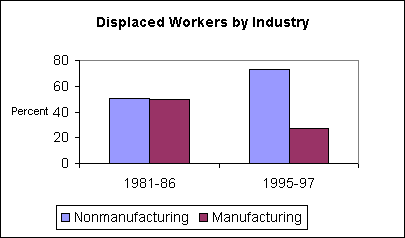An official website of the United States government
 United States Department of Labor
United States Department of Labor
From 1995 to 1997, worker displacements in nonmanufacturing industries—including services, retail trade, and finance, insurance, and real estate—accounted for a larger share of total worker displacements than was the case in the early 1980s.

[Chart data—TXT]
In contrast, displacements from manufacturing industries now account for a much smaller share of the total. In the early 1980s, nearly 1 in 2 job displacements were from manufacturing. By the 1995-97 period, this proportion had fallen to roughly 1 in 4.
Although the shift in industrial composition of displacement partially reflects the shift in employment to the nonmanufacturing sector, the proportion of displacements occurring in nonmanufacturing industries has grown more than nonmanufacturing's share of total employment. For example, since the early 1980s, the share of displacements occurring in services doubled from 10 to 20 percent, while the share of employment in services rose from 16 to 22 percent.
These data are from a supplement to the February 1998 Current Population Survey (CPS), a monthly nationwide survey of about 50,000 households that provides basic data on national employment and unemployment. The Employment and Training Administration of the U.S. Department of Labor has sponsored biennial surveys on displaced workers since 1984. Additional information is available from news release USDL 98-347, "Worker Displacement, 1995-97".
Bureau of Labor Statistics, U.S. Department of Labor, The Economics Daily, Nonmanufacturing workers face increasing incidence of job displacement at https://www.bls.gov/opub/ted/1998/oct/wk2/art03.htm (visited December 30, 2025).

